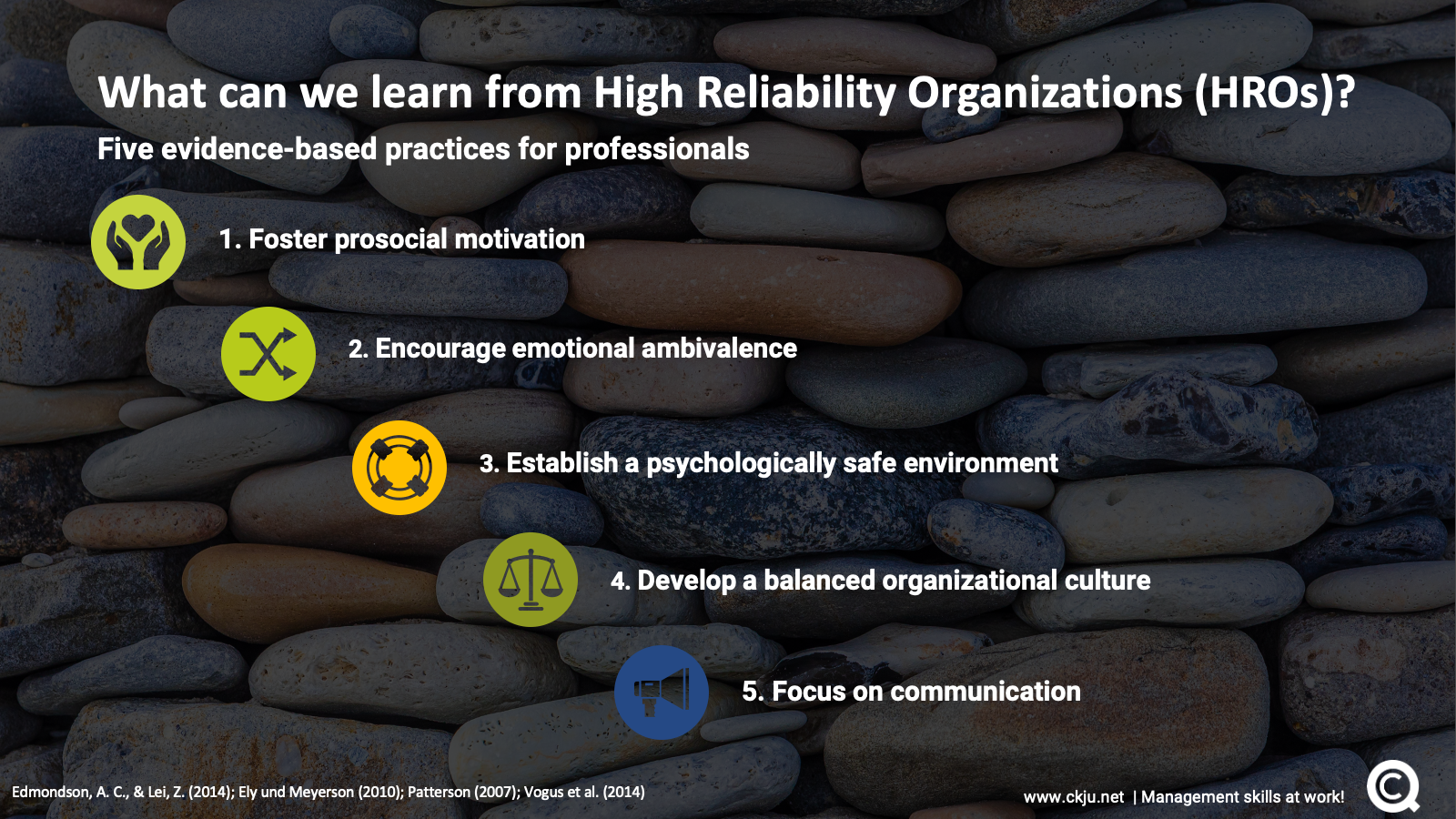- Blog
- High reliability organizations
Contents
- It is important to recognize risks, deviations and problems
- Fostering pro-social motivation helps orientation towards others
- Encourage emotional ambivalence and avoid getting trapped in the comfort zone
- Establish a psychologically safe environment and nurture communication
- Develop a balanced organizational culture by increasing diversity
- Focus on communication - the more the better
- HRO engage in unique ways to learn and innovate
- High Reliability Teams (HRT) are a means to promote safety in an organization
- References and further reading
It is important to recognize risks, deviations and problems
There are numerous cases where managers recognized issues too late and as a consequence put an organization into harms way. A full blown crisis with an organization’s survival at risk can be the consequence (Foster and Kaplan 2008) in a worst case scenario. Recent examples like Lehmann Brother’s and Kodak’s bankruptcy, Nokia’s decline (McCray et al. 2011), BP’s Deepwater Horizon oil spill, Greek’s potential withdrawal from the Eurozone and VW’s Diesel crisis remind us that such a worst case scenario is not as unrealistic as it might sound at first glance.
Fortunately, as managers we usually face less severe issues such as budget overruns, time delays and quality issues. However, there is a fine line between projects spinning out of control and a full blown crisis. When it comes to work accidents HROs and other organizations share the same objective: zero accidents. What can we learn from HROs to detect issues early enough or avoid them at all?
Fostering pro-social motivation helps orientation towards others
The famous motto “one for all, all for one” from Alexandre Duman’s novel “The Three Musketeers” points out the key characteristic of pro-social individuals. In a process called mindful organizing (Weick and Sutcliffe 2006) prosocial individual contribute to high reliability by recognizing and raising issues early and holistically. Instead of putting individual interests highest on the agenda, pro-social individual tend to keep an eye on developments that are relevant for their teams and the entire organization. They are other-oriented (Vogus et al. 2014) and see it as part of their responsibility to contribute to the positive development of the organization.
Encourage emotional ambivalence and avoid getting trapped in the comfort zone
Do you remember a situation where you simultaneously experienced happiness and sadness or hope and fear? This state of mind is called emotional ambivalence and increases the quality of decision making (Rees et al. 2013). It makes us look at the world from different perspectives and engage in deep information processing. Emotional ambivalent individuals avoid the comfort zone trap. They don’t get caught into too optimistic and pessimistic situational judgements but engage in a more balanced decision making process (Vogus et al. 2014). Emotional ambivalence is another contributor to mindful organizing which is a key characteristic of HROs.
Establish a psychologically safe environment and nurture communication
Do your employees speak-up when they think they recognize something noteworthy? Do your team members share their knowledge with each other? When you can truly answer these questions with “yes” you most properly managed to establish a work environment that is characterized by psychological safety. When people feel safe in their work environment they take interpersonal risks by speaking up and sharing their knowledge with others (Edmondson and Lei 2014). Thus, establishing a psychological safe work environment is priority one when you want your organization to address risks and opportunities as early as possible.
Develop a balanced organizational culture by increasing diversity
There is plenty of research supporting the claim that companies with a masculine dominated organizational culture tend to prioritize a risk-taking and firefighting mentality over issue avoidance (Ely and Meyerson 2010). When you as a leaders represent this “Great men are forged in fire” mentality, you are going to reinforce this type of behaviour by incentivising it (Collinson and Hearn 1996). And yes, masculine dominated organizational cultures are usually traditional male occupations which tend to encompass physical risks (Ely and Meyerson 2010). You can implement measures to increase diversity and conduct training sessions that address the risks of a masculine dominated organizational culture.
Management skills newsletter
Join our monthly newsletter to receive management tips, tricks and insights directly into your inbox!
Focus on communication - the more the better
Communication is the lifeblood of any organization. Operating in a highly sophisticated and dynamic environment, HROs have developed a unique approach to communication that can be applied in other organizations as well (Patterson et al. 2004). Communication in this context is more than verbal communication between individuals. It covers any mean of communication such as visualization, gesture, electronic communication and traditional face-to-face communication. The easy to apply heuristic reduce, reveal and focus grasps the way HRO communicate (Patterson 2007).
Reduce complexity
The first principle “reduce” refers to activities to keep complexity at bay. When applied to an operations setting, reduce can be implemented by visualizing different production and logistics areas. This makes it much easier to identify those areas and address them by production employees. However, don’t mix reduce with simplify. HROs are reluctant to simplification since the devil is in the details (Weick and Sutcliffe 2015).
Increase transparency
Transparency is another key characteristic of HROs. When people have to engage in long discussion before they understand that the organization is in turmoil, it could be too late (Bigley and Roberts 2001). The second principle “reveal” addresses the need to minimize hidden actions and events that could take people by surprise (Patterson 2007). You could for instance meet with your management team once a week for a short briefing on recent events. Well known approaches that apply the reveal principle are Shop Floor Management meetings in product and daily stand-ups or SCRUM meetings in product development teams.
Continuously re-align your organization's focus
The third principle “focus” refers to distinguishing the important things from the less important ones. While this sounds obvious at first glance, it is a challenging endeavour in an environment where things can rapidly change such as wildfires and severe weather conditions. The same thing applies to a complex business environment. A critical customer feedback can lead to a major crisis when not recognized and dealt with accordingly. Quality issues in software systems and complex machinery can lead to unplanned shutdowns of factories, companies and governmental organizations. HROs are sensitive to operations (Weick and Sutcliffe 2015). They respect and listen to employees working on the frontlines and thus are up to date when it comes to changes in their environment. When have you met your production, service or sales people the last time? Do you and your team members know the three most important issues to be solved in the next six months?
HRO engage in unique ways to learn and innovate
HRO cannot afford to learn and innovate from mistakes. The risk of creating havoc is simply too high. Thus, HRO found different ways to engage in learning and innovation. While as managers we work hard to create a safe environment where people are allowed to make mistakes and learn from them, there are exceptions where we better refrain from it. This especially applies to highly sophisticated projects with tough time restrictions. In the blog post we introduced a set of evidence-based practices that help you as manager or professional to learn from the unique way of delivering high performance in a challenging environment.
High Reliability Teams (HRT) are a means to promote safety in an organization
Teams working in HROs manage to translate the values HROs strive for to a team behavioral level (Wilson, Burke, Priest & Salas, 2005). By doing this High Reliability Teams (HRTs) reach an outstanding safety level while keeping efficiency high. You should consider HRTs as blueprint when you want to increase the workplace health and safety level in your organization.
References and further reading
Bierly, I. Paul E.I.I.; Gallagher, Scott; Spender, J. C. (2008): Innovation and Learning in High-Reliability Organizations. A Case Study of United States and Russian Nuclear Attack Submarines, 1970–2000. In: IEEE Trans. Eng. Manage. 55 (3), S. 393–408. DOI: 10.1109/TEM.2008.922643.
Bigley, G. A.; Roberts, K. H. (2001): THE INCIDENT COMMAND SYSTEM. HIGH-RELIABILITY ORGANIZING FOR COMPLEX AND VOLATILE TASK ENVIRONMENTS. In: Academy of Management Journal 44 (6), S. 1281–1299. DOI: 10.2307/3069401.
Collinson, David; Hearn, Jeff (1996): Men as Managers, Managers as Men. Critical Perspectives on Men, Masculinities and Managements. 1 Oliver's Yard, 55 City Road, London EC1Y 1SP United Kingdom: SAGE Publications Ltd.
Edmondson, Amy C.; Lei, Zhike (2014): Psychological Safety. The History, Renaissance, and Future of an Interpersonal Construct. In: Annu. Rev. Organ. Psychol. Organ. Behav. 1 (1), S. 23–43. DOI: 10.1146/annurev-orgpsych-031413-091305.
Ely, Robin J.; Meyerson, Debra E. (2010): An organizational approach to undoing gender. The unlikely case of offshore oil platforms. In: Research in Organizational Behavior 30, S. 3–34. DOI: 10.1016/j.riob.2010.09.002.
Foster, R. N.; Kaplan, S. (2008): Survival and Performance in the Era of Discontinuity. In: W. W. Burke, D. G. Lake und J. W. Paine (Hg.): Organization Change. A Comprehensive Reader: John Wiley & Sons (J-B Warren Bennis Series).
McCray, John P.; Gonzalez, Juan J.; Darling, John R. (2011): Crisis management in smart phones. The case of Nokia vs Apple. In: European Business Review 23 (3), S. 240–255. DOI: 10.1108/09555341111130236.
Patterson, Emily S. (2007): Communication strategies from high-reliability organizations. Translation is hard work. In: Annals of surgery 245 (2), S. 170–172. DOI: 10.1097/01.sla.0000253331.27897.fe.
Patterson, Emily S.; Roth, Emilie M.; Woods, David D.; Chow, Renée; Gomes, José Orlando (2004): Handoff strategies in settings with high consequences for failure. Lessons for health care operations. In: International journal for quality in health care : journal of the International Society for Quality in Health Care 16 (2), S. 125–132. DOI: 10.1093/intqhc/mzh026.
Rees, Laura; Rothman, Naomi B.; Lehavy, Reuven; Sanchez-Burks, Jeffrey (2013): The ambivalent mind can be a wise mind. Emotional ambivalence increases judgment accuracy. In: Journal of Experimental Social Psychology 49 (3), S. 360–367. DOI: 10.1016/j.jesp.2012.12.017.
Vogus, Timothy J.; Rothman, Naomi B.; Sutcliffe, Kathleen M.; Weick, Karl E. (2014): The affective foundations of high-reliability organizing. In: J. Organiz. Behav. 35 (4), S. 592–596. DOI: 10.1002/job.1922.
Weick, Karl E.; Sutcliffe, Kathleen M. (2006): Mindfulness and the Quality of Organizational Attention. In: Organization Science 17 (4), S. 514–524. DOI: 10.1287/orsc.1060.0196.
Weick, Karl E.; Sutcliffe, Kathleen M. (2015): Managing the Unexpected: Sustained Performance in a Complex World. 3rd Edition: Wiley.
Wilson, K. A., Burke, C. S., Priest, H. A., & Salas, E. (2005). Promoting health care safety through training high reliability teams.BMJ Quality & Safety, 14, 303-309.
Top Rated
About the Author

Comments
Most Read Articles
Blog Categories
RELATED SERVICES










Add comment